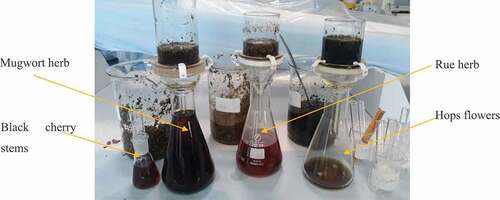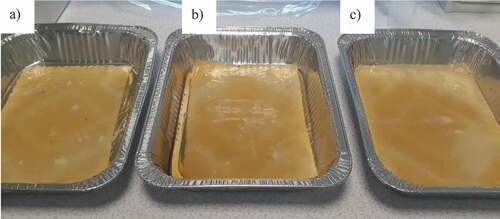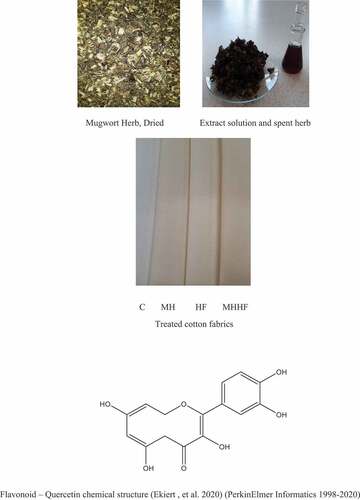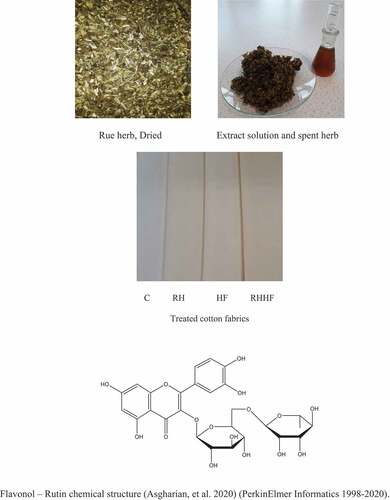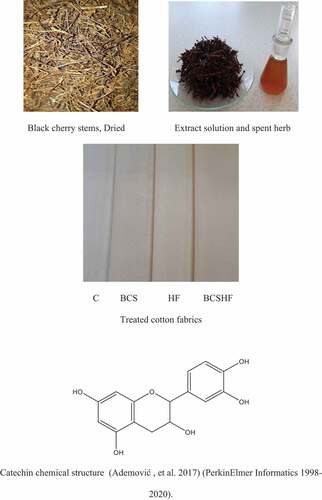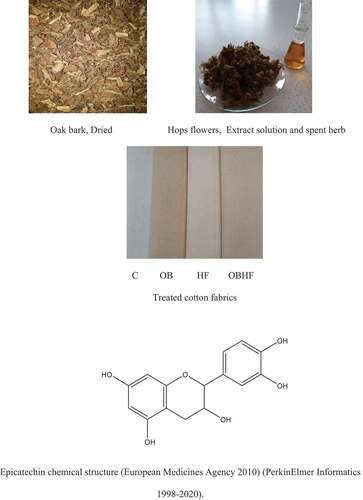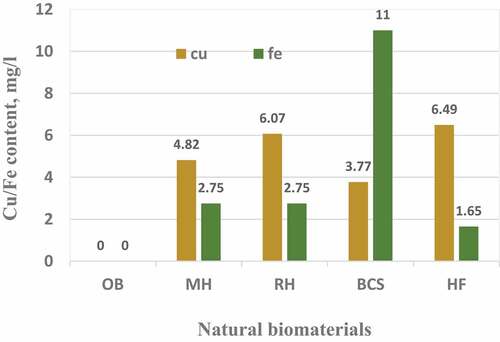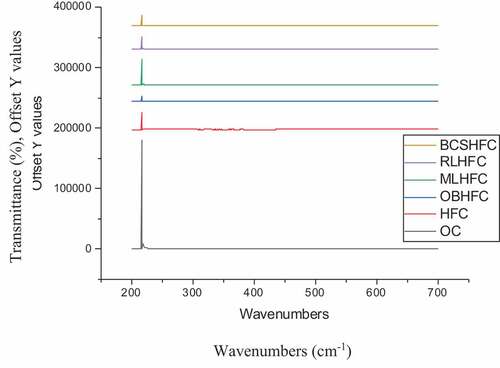 ?Mathematical formulae have been encoded as MathML and are displayed in this HTML version using MathJax in order to improve their display. Uncheck the box to turn MathJax off. This feature requires Javascript. Click on a formula to zoom.
?Mathematical formulae have been encoded as MathML and are displayed in this HTML version using MathJax in order to improve their display. Uncheck the box to turn MathJax off. This feature requires Javascript. Click on a formula to zoom.ABSTRACT
Sustainable Development Goals (SDGs) promote the utilization of renewable materials and processing methodologies for achieving circularity in the fashion industry production. Hence, the research was initiated to investigate the innovative and renewable plant-based sources of mordants and colorants for textiles that benefit the environment and human health alike. The research examinations established mugwort herb, rue herb, black cherry stems, and hops flower as a sustainable and innovative source of mordants and colorants on cotton fabrics. The Atomic Absorption Spectrometry (AAS) analysis of 6% stock herbal infusions identified the highest levels of copper and ferrous content in hops flower, and black cherry stems of 6.5 mg/l and 11 mg/l respectively as a prospective renewable and innovative source of mordants and colorants. Their applications on textiles would prevent the fatal mining and depletion of mineral ores of copper and ferrous elements, and metal toxicity to the ecosystem would be combated. Very good rub fastness and wash fastness to color staining, on the other hand, fair lightfastness ratings were gained. The cotton fabrics pre-treated with black cherry stems and colored with hops flowers exhibited the minimum transmittance percentage in the UVB region at 12.98% therefore practically appropriate for summer wear. Evaluation of ecological parameters, ATR-FTIR study of herbs and their treated fabrics, and Life Cycle Analysis is recommended for future work.
Introduction
Troubled water and air from textile effluents and emissions impel carbon neutrality imperatively. Therefore, the European Green Deal legally applies no ‘safe’ use of hazardous chemicals to avoid their use altogether in the first place. It particularly applies to bioaccumulative substances namely perfluorocarbons (PFCs) and all other chemicals that have been linked to cancer, genetic mutation, impact on reproduction, and the endocrine system. It has banned hazardous chemicals used in textiles, toys, furniture, cosmetics, and varied end uses (Ecotextile news Citation2020) (Tang, Lo, and Kan Citation2018). Likewise, Greenpeace international commenced Detox My Fashion campaign in 2011 to guarantee that clothing was exempt from hazardous chemicals from make to finish. They further launched Zero Discharge of Hazardous Chemicals (ZDHC) wherein they predominantly accentuate implementing eco-smart processes and safe Chemicals in textile processing units. ZDHC formulated a Manufacturing Restricted Substances List (M-RSL), which appeals to mandatorily eliminate 11 priority hazardous chemical groups. It prohibits the use of heavy metals namely chromium, copper etcetera also alkylphenol ethoxylates (APEs), polyfluorinated chemicals (PFCs), and phthalates. The list of restricted carcinogenic dyes for example azo dyes, disperse dyes, and anti-microbial's namely triclosan etcetera are detailed in the ZDHC M-RSL (Stichting ZDHC Foundation Citation2022) (Greenpeace International Citation2013). This impels the research and development of alternative biodegradable and renewable sources of natural materials for the application of textile substrates for coloration and functionality namely UV protective, antimicrobial and others, hence the initiated research. Of particular concern are the depletion of mineral ores namely copper and ferrous utilized in textile processing units for varied purposes such as being used as mordants for natural coloration of textiles to enhance the fastness properties. However, the fossil-based mordants, aluminum sulfate, ferrous sulfate, and copper sulfate are not ecological (Vankar and Shukla Citation2019) (Britland Citation2013). Therefore, it is imperative to replace synthetic elements with renewable plant-based sources of iron and copper aides for application on textile substrates for ecological outcomes and human health benefits alike hence the originated research. Water and land pollution occurring due to copper extraction from mines is depicted in (Britland Citation2013). The wheel maid an old copper mine near St. Day, Cornwall, UK was investigated by the environment agency, and it was found that soil and water near the mine had high levels of arsenic, copper, and zinc, therefore unsafe for human habitation (Green Citation2021). Note, not all the mined copper and ferrous metal is housed in the textile industry however the proportion is high therefore objectionable to the environment and human health. The water reservoirs and streams beneath 20-year-old copper and zinc mines were observed to be devoid of biota. High levels of metals such as zinc, copper, and copper sulfate are poisonous for marine life algae including phytoplankton, zooplankton, fishes, and others thereby disrupting the entire ecosystem in which several species live in an organized symbiotic relationship (Horne and Goldman Citation1994). Concurrently, Vankar et al. reported that traditional chemical metallic mordants are typically utilized in an aqueous solution of 20 g/l ferrous sulfates, alum, copper sulfate, potassium dichromate, stannous chloride, and stannic chloride for fixing natural colors to be used on textile substrate. However, its effluent requires special treatment before safe disposal, it depletes the mineral ores and is therefore not sustainable (Vankar and Shukla Citation2019). To explore biomordants, Rubia Cordifolia also known as Indian madder was utilized to dye cotton fabric with pre-treated biomordant Eurya acuminate dc var euprista Karth (Theaceae family). The plant contains 11.767 mg/l of Al. The high Al content acts as a chelate and bonds coloring anthraquinone moiety of R. Cordifolia at two different sites of its molecule: one with carbonyl and hydroxyl and the other with di-hydroxyl moieties, referring to (PerkinElmer Informatics Citation2017). It was found that aluminum-containing bio-mordant enhanced the wash and light fastness properties, and good calorimetric data were obtained on dyeing (Vankar et al. Citation2008) (). Previous research established tannins from dried fruits of Emblica Officinalis (Amla) as an efficient source of mordant. Pre-treated cotton fabrics were dyed with turmeric, henna, pomegranate, and madder. Shades obtained were yellow, grey, khaki, and pink, respectively (Prabhu, Teli, and Waghmare Citation2011). The natural plant source of mordant is sustainable and the treated fabrics exhibited excellent anti-bacterial properties which effectively continued up to 10 wash cycles with a steady decline. Very good to excellent wash, light, and rub fatness ratings of 4–5 and 5 were obtained with pre-mordanted fabrics, referring to . Copper sulfate was implemented as one of the mordants however it now appears in the restricted chemical list by the United States Environmental Protection Agency (EPA), Registration, Evaluation, Authorization, and Restriction of Chemicals (REACH), and Greenpeace International (ZDHC–MRSL) This is because metallic mordants from copper, ferrous, stannous, and aluminum metals are depleting the mineral ores, creating adverse effects on human health and aquatic life therefore not ecological and hence legally discontinued (Thakker and Sun Citation2021a). It was justified that Emblica officinalis tannins are phenolic compounds enclosing 728.17 mg/g gallic acid equivalent. The Folin-Ciocalteu method was implemented for the determination of phenolic compounds (Prabhu, Teli, and Waghmare Citation2011). Plant-based tannin-containing mordants are highly efficient and commendable. They are also ubiquitous and surplus in availability. Nonetheless, not all synthetics are appalling or could be replaced, those listed in the M-RSL, resulting in enormous pollution and health problems require to be substituted. The negative impacts of overconsumption, over industrialization, and non-biodegradability due to fossil-based materials in the textile chain need to be addressed (Stichting ZDHC Foundation Citation2022) (Thakker and Sun Citation2021a). The biomimicry an inspirations from nature could greatly help us in the same, hence the initiated research (Minney Citation2016). Overall, there seems to be some evidence that sustainable auxiliaries play a vital role in deriving sustainable outcomes for ecological benefits. Interestingly, how tannic acid adsorption occurs in silk fiber was extensively studied by Zhang and his colleagues. As indicated by the UV-Vis spectrophotometer tannic acid exhaustion percentage was increased to 80.5% at pH 3 from 37.4% at pH 7. Likewise, when the temperature was increased from 70°C to 90°C, the adsorption of tannic acid showed a downward trend. This is attributed to ion–ion interactions between amino groups in silk fiber and phenolic hydroxyl groups in tannic acid molecules under acid conditions leading to good chemisorption. It was found that untreated silk fabric had an antioxidant activity of 32.3%, whereas 2% (owf – on the weight of fabric) tannic acid-treated silk fabric demonstrated an excellent antioxidant activity of 99%. Also, 0.5% (owf) tannic acid-treated silk fabric exhibited excellent antibacterial activity of 98% toward E. coli and S. aureus strains of bacteria. Again, here the higher number of phenolic hydroxyl groups presented in tannic acid contributed to its excellent antioxidant and antibacterial ability (Zhang et al. Citation2019). In the same vein, Phan and the team reported that natural colors are environmentally sensible however the utilization of metallic mordants do not resonate with the green story, therefore, the team investigated the potential of anthocyanins from blueberry waste for coloring cotton fabrics with natural mordants namely oxalic acid dihydrate, sodium alginate, β-cyclodextrin, tannic acid, gallic acid, and caffeic acid. They studied the possible intermolecular interactions considering hydrogen bonds, ionic bonds, π-π bonds in color-mordant-fabric complex formation. The aqueous extraction was performed for one hour at 60°C. Alcohol-based solvent ethanol/methanol extraction was avoided to prevent its emissions. The coloration of cotton fabric with blueberries extracts at 90°C demonstrated degradation of anthocyanins therefore lower L* and a* values were observed. The molecular dynamics were studied with natural mordants rich in hydroxyl groups (-OH) that is, tannic acid, sodium alginate and β-cyclodextrin. Overall, it was concluded that the dye-mordant complex formation is governed by the π-π weak bonds and strong hydrogen bonds. Hence, it would be vital to enhance the hydrogen bonding to attain higher color values and fastness ratings (Phan et al. Citation2020). Additionally, Yang et al. dyed biomordanted cotton and hemp fabrics with leftover madder root, that remained after the first aqueous extraction of madder root. The applied biomordants namely C. speciosa and gum rosin indigenous to China were concluded to be effective. However, in contrast to the earlier study, the recycled madder root extraction method utilized ethanol extraction which was not cohesive with the green agenda, and it could be certainly substituted with distilled or plain water to acquire recycled madder root extract (Yang Citation2019). Until recently, there has been little research on the UV-protective performance of treated/mordanted textiles. Fabrics are expected to be protective against sun rays causing skin cancer (UVA). In a study investigating biomordants, Bonet reported that low and high molecular weight chitosan can be effectively implemented for pre-treating cotton fabrics. The treated fabrics were colored with Eisenia Bicyclis, a seaweed extract. It was reported that the application of chitosan biomordant enhanced the color strength and color uniformity on treated cotton fabric. (Bonet-Aracil et al. Citation2016) illustrates the Ultraviolet protective factor of (1) untreated cotton fabric, (2) low molecular weight chitosan treated cotton fabric, and (3) medium molecular weight chitosan treated fabric. Surprisingly, the ultraviolet protection factor was excellent in the fabric treated with medium molecular weight chitosan (Bonet-Aracil et al. Citation2016). Additionally, in a noteworthy research examination performed by Ellams, 100% Tencel fabrics were treated with eucalyptus leaves and bark extract. The treated fabrics were evaluated on UV-Vis Spectrophotometer and demonstrated less than 10% transmittance in the UV region, whereas the untreated fabric exhibited 40–50% transmittance. Thus, the eucalyptus extract solution-treated fabrics were concluded to be UV protective and suitable for summer wear (Ellams Citation2017). Since tannins are ubiquitous a considerable amount of literature has been published on tannins, referring to . Collectively, there is a relatively small body of literature that is concerned with natural additives. Overall, these studies highlight the need for research and experimentation on plant-based mordants and those containing iron and copper remain to be identified and tested for their applications on natural textiles. There is a lack of literature and scientific rationalization about their functionality on textile substrates. There remain several aspects of natural additives from plants about which relatively little is known. Therefore, the study instigated the extraction from the surplus mugwort plant known to be an iron accumulator enclosing 1,200 to 3,900 mg/l of iron in its dry leaves. Similarly, surplus black cherry stems extract encloses 1.3 to 378 mg/l of copper in dry stems (Alchemy website Citationn.d.). Therefore, enhanced functional properties are anticipated of the treated fabrics. Plants as sources of copper and ferrous would prevent the depletion of mineral ores of the corresponding metals. Plant-based metal additives are renewable and biodegradable, thus sustainable. Recently, several authors have contributed to the study of natural tannin based mordants on a textile substrate with subsequent coloration with plant-based colorants as cited in (Ismal, Yıldırım, and Ozdogan Citation2014) (Mahreni, Priambudi, and Sugiarti Citation2019) (Guesmi et al. Citation2013) (Hosen et al. Citation2021) (Barahapurkar, Purwar, and Baldua Citation2020) (Habib et al. Citation2021). A team of authors performed ethanol solvent extraction of colorants from mugwort leaves powder under acidic conditions. The UV-Visible analysis identified Eupalitin, Jaceosidin and Neochlorogenic acid as predominant chemical components. The highest peaks at 3423–3389 cm−1 were obtained with FTIR having strong and broad -OH bearing benzene rings of tannin and flavonoid. Dark brown, light brown, and gray hue and tones were obtained on un-mordanted and Fe2+ and Al3+ salts mordanted wool fabrics. Good to excellent wash, light, and rub fastness test results were obtained with wool fabric samples. Wool fabrics colored with mugwort leaves demonstrated low UVA and UVB levels of transmittance and high UVF levels therefore good UV protection (Jameel et al. Citation2020). Since the research adopted fossil-based salts and solvents, the results are not sustainable. Grey literature mentions the implementation of hops flowers for coloring cellulosic papers. Considering all the evidence, it can be concluded that there remain several aspects of these herbs namely mugwort herb, rue herb, black cherry stems and hops flowers that are known little relatively. Hence the instigated research further explores these herbs as a sustainable source of bio-mordants and colors for textile applications and functional fabrics.
Figure 1. Land and water pollution at an old copper mine near St. Day, Cornwall, UK (Alamy Ltd. 2021).
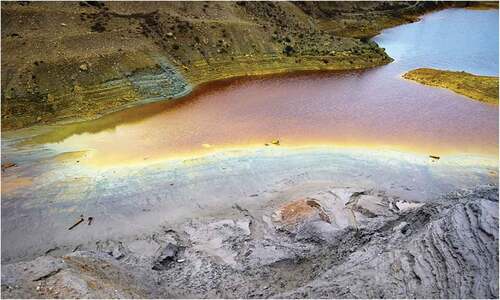
Figure 2. Biomordant Aluminum from Eurya acuminate dc var euprista Karth bond formation with anthraquinone dye molecule from Rubia cordifolia (PerkinElmer Informatics Citation2017).
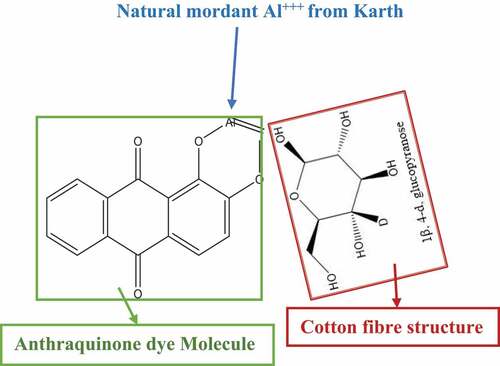
Figure 3. Ultraviolet property of cotton fabrics treated with biomordant chitosan (Bonet-Aracil et al. Citation2016).
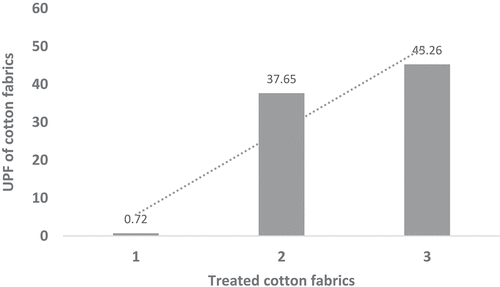
Table 1. Light and wash fastness properties of cotton fabrics mordanted with Amla (Prabhu, Teli, and Waghmare Citation2011)
Table 2. Natural mordants and colorants on natural textile substrate. (Ismal, Yıldırım, and Ozdogan Citation2014) (Mahreni, Priambudi, and Sugiarti Citation2019) (Guesmi etal. Citation2013) (Hosen etal. Citation2021) (Barahapurkar, Purwar, and Baldua Citation2020) (Habib etal. Citation2021)
Materials and methods
Materials
Cotton fabric was sourced from Whaley’s Bradford Ltd. UK, refer to for its specifications. For mordanting the cotton fabric, raw natural materials namely mugwort herb, rue herb and black cherry stem were utilized. The standard mordant was sustainably extracted from oak bark likewise natural color was obtained from the hops flower. The herbs were sourced from Just Ingredients Limited, UK, the details are shown in along with their potential functionality on textile substrates. For enhanced absorption as revealed on surface contact angle preliminary test, the ready-to-dye cotton fabric was washed with fresh water at a temperature of 70°C. The fabric was squeezed and dried for further use. The wettability as indicated on the surface contact angle before and after wash was 83.34°/4.28 µl and 63.97°/1.70 µl respectively, at 0.27 second after the droplets were dropped on the surface of the two fabric samples. The Oneattension surface contact angle was utilized for the purpose with Young-Laplace contact angle as the mode of analysis. A surface contact angle being less than 90° the contacted fabric surface is termed as hydrophilic, whereas a surface contact angle being over 90° the contacted fabric surface is termed as hydrophobic. Therefore, the washed cotton fabric is hydrophilic hence suitable for further experiments of mordanting and coloration.
Table 3. Cotton fabric specifications
Table 4. Profiles of plants as a source of sustainable mordants and colorants for the natural textile substrate
Methods
Herbal infusion and extraction
Raw herbal leaves of 30 grams were infused in 500 ml of distilled water at 60°C and steeped for 2 hours for the extraction process to complete sustainably. The extract was filtered with Whatman glass microfiber filters of 70 mm. Six percent of the moderate stock solution was prepared to be further utilized for cotton fabric treatment, referring to . Herein, note that 1-gram herb in 100 ml water creates a 1% stock solution. The prospective research preliminary trials and previous studies revealed that natural phytochemicals responsible for functionality and coloration on a textile substrate are preserved at low infusion temperatures and low dilution, using water as solvent. Therefore, greater functional benefits and original color are achieved with minimal heat concoctions of herbal leaves, stems, barks, buds, and flowers. At the same time, being low on energy, water, and no synthetic solvent demands would impel sustainable results (Manimozhi and Kanakarajan Citation2017) (Zhang et al. Citation2019) (Jeanroy Citation2019). The naturally occurring plant phytochemicals namely polyphenolic compounds, for example, quercetin, kaempferol, catechins, anthocyanins, etc. contained in herbs namely cloves, green tea, mango ginger, kattha others responsible for antioxidant, anti-microbial, anti-inflammatory functionality are very sensitive to heat treatment and are expended on boiling. The temperature of water between 30°C and 60°C is most advantageous for maintaining original color stability and functional phytochemical contents (Manimozhi and Kanakarajan Citation2017) (Thakker and Sun Citation2021b) (Buckley Citation2019). Subsequently, low temperature, slow extraction, and coloration were concluded to be conducive for the processing of natural fibers and fabrics with natural herbs.
Mordanting process
For 30% strength of treatment 6% of the prepared herbal extract stock solution of mugwort herb, rue herb, and black cherry stems were utilized for the treatment of cotton fabric samples. The average weight of the cotton fabric samples was 9 grams/piece. The cotton fabric samples were steeped for an hour at 30°C with material to liquor (M:L) ratio of 1:10. The treated fabrics were shade dried. In the same vein, reheating, and prolonged heating at a temperature beyond 60°C perishes the phytochemicals for example 62% of the phenolic acids would get destroyed in 2 minutes at 100°C of boiling temperature (Jeanroy Citation2019) (Buckley Citation2019). Therefore, the pure extract solution was not rewarmed, and the cotton fabric was processed at room temperature. Hence, the devised process adheres to sustainable development goals (SDGs) and the principles of green chemistry (United Nations Citation2021) (The University of Queensland Citation2020). Note, the higher the wettability value of cotton fabric the greater the K/S value would be at a low temperature of coloration (Shore Citation1990), hence vital for sustainability-oriented research. The following EquationEquation (1)(1)
(1) (Wiley Citation2016) was applied in keeping the M:L as 1:10.
Coloration of fabrics
The 30% depth of shade, on the weight of fabric (owf) of the herbal color extract solution prepared from whole hops flowers, was utilized for coloring cotton fabrics. The mordanted fabrics were soaked in a mild color extract solution for 2 hours at 25°C (low-temperature demand) with material to liquor ratio of 1:10 (low water demand), referring to . The colored fabrics were dried at room temperature. The process is simple and clean, involving no emissions and effluents. The spent bath is biodegradable. The leftover herbs could be further utilized for strong decoctions to obtain increased color depth and improved fastness properties and could be dried to be implemented as garden manure and or cattle feed. The method of color measurement on datacolor 600, the characterization of herbal materials on Fourier Transform Infrared Spectroscopy (FTIR), Atomic Absorption Spectrometry (AAS), also Transmittance (%) evaluation using UV/Vis Spectrophotometer and the methods of fastness tests implemented in the research are documented as supplementary materials.
Results and discussion
Evaluation of extraction method, bio-mordanting, and coloration with innovative herbs
Extraction, the method of infusion obtained mild (6%) herbal extract solution sustainably. The leftover herbs could be further utilized to obtain strong herbal concoctions. The leftover herbs could be utilized as manure in gardens and as fodder mix for cattle feed.
Bio-mordanting, the method of mordanting cotton fabric before coloration with hops flowers was simple and clean. The method is low on energy and water demands.
Coloration, the method of coloration is low on energy and water demand. The surplus solution is biodegradable. Hence, the research establishes ecological methods of processing textiles that would benefit the environment. present the colors obtained with hops flowers.
The results obtained with the above method implementing the new herbs used in this research are consistent with results obtained with reference herb that is Oak bark on cotton fabric. It reinforces that the method is reliable and evidently reproducible. However, statistical analysis is recommended for future work.
Colors acquired on the cotton fabrics, the colors acquired on the cotton fabrics processed with novel sources of herbs as biomordants and colorants are illustrated in . (Ekiert et al. Citation2020). (Asgharian et al. Citation2020). (Ademovi et al. Citation2017). (European Medicines AgencyCitation2011).
Color values
The color values obtained on cotton fabrics processed with innovative sources of biomordants namely, oak bark, mugwort herb, rue herb and black cherry stems are illustrated in . The mild herbal infusions of rue herb and black cherry stem sustainable applied on the cotton fabrics yield the highest absorbance values at 5.36 and 4.27, respectively. The herbs could function as both mordants and colors. The high L* values markedly indicate that the colors attained with gentle herbal concoctions are light. The greater positive a* value noted with mugwort herb denotes its color toward red. Likewise, the positive larger b* values achieved with rue herb and black cherry stems signify the colors toward yellow. Eventually, the hue acquired with mugwort herb is light red, and a light-yellow tone was attained with rue herb and black cherry stem. The color values obtained on ecologically mordanted cotton fabric colored with hops flowers are illustrated in . The moderate herbal infusions yield moderate K/S values on the processed cotton fabrics. The highest K/S was obtained on cotton fabric pre-treated with the black cherry stems and thereafter colored with hops flowers. This could be attributed to the high ferrous content inherently present in black cherry stems as validated on Atomic Absorption Spectroscopy (AAS). As per AAS readings, the black cherry stem encloses 11 mg/l of ferrous content in 6% (owf) of its herbal infusion in distilled water as solvent. The absorption is ranked second on cotton fabric pre-treated with rue herb followed by coloration with hops flowers. This could be credited to the high copper content inherently presented in both the rue herb and the hops flowers of the value 6.07 mg/l and 6.49 mg/l respectively as validated on AAS. The application of herbs namely mugwort herb, rue herb and black cherry stems on cotton fabric as biomordants distinctly enhances the absorption of successive coloration with hops flowers, referring to . It ascertains the functionality of mugwort herb, rue herb and black cherry stem as sustainable sources of mordants inherently containing copper and iron. Equally, the high L* values noticeably catalog light tone colors acquired with herbs, and distinctly the hues have shifted more toward yellow tone as indicated by positive b* values obtained after coloration with hops flowers. It is to be noted that the herbs when in the process, each had a distinctly pure and gentle aroma and so are the colors acquired with it. The presence of aromatic C-H bends as identified in ATR-FTIR further emphasizes the occurrence of aromatic phytochemicals in herbs and the treated cotton fabrics. Furthermore, the color difference ΔE was noted to be of the maximum value of 8.018 for cotton fabric samples pre-treated with black cherry stem and afterward colored with hops flowers followed by the ΔE value of 7.490 obtained on the cotton fabric biomordanted with mugwort and colored with hops flowers and a low ΔE value of 2.35 was observed for the cotton fabric biomordanted with rue herb and subsequently colored with hops flowers. The standard oak bark treated cotton fabric then processed with hops flowers had a ΔE value of 4.349. Lastly, the original white cotton fabric samples were colored with hops flowers with no biomordant applied demonstrating 15.466 for ΔE. The color difference is derived from the L*, a*, and b* color values obtained in (Biomordanted) & (Biomordanted + Colored). The formula shown in Equation (2) was applied to gain the ΔE values. The colors obtained on cotton fabric samples after biomordanting, and coloration are perceptible at a glance as per the Delta ΔΕ scale shown in Supplementary .
Table 5. Color values were obtained on cotton fabrics treated with innovative herbs
Table 6. Color values of pre-treated & colored cotton fabrics were obtained on Datacolor 600
Atomic Absorption Spectroscopy (AAS)
The AAS analysis of the 6% of herbal extract solutions identified the presence of copper and ferrous elements as illustrated in . The mild herbal infusions of Black cherry stems were high in iron content, which is 11 mg/l. The rue herb and hops flower had high copper content of 6.07 and 6.49 mg/l, respectively. These findings are significant to support the hypothesis as it confirms the presence of copper and ferrous content in substantial proportion, rendering them suitable as prospective mordants and/or colors for the natural textile substrate. The herbs namely, mugwort herb, rue herb, black cherry stems and hops flowers pure extracts would further enhance the color depth and fastness properties on textile substrates. Therefore, it would make a larger color palette available to the designers, cottage industries and consumers.
UV protection (UVP) analysis
The transmittance graph obtained for the biomordanted cotton fabrics colored with hops flowers is illustrated in . The mean transmittance percentage values at different wavelengths (VR = visible range, UV = ultraviolet range) (World Health Organisation Citation2016) are comprised in . Note, UVC does not reach the earth surface as it is absorbed by the atmosphere (World Health Organization Citation2022). It can be noted that the UV transmittance has markedly dropped for the cotton fabrics pre-treated with biomordants and colored with hops flowers as compared to the original cotton fabric. Therefore, the treated fabrics are practically suitable for summer wear. Among the new herbs that were experimented with, the cotton fabrics pre-treated with black cherry stems and colored with hops flowers (BCSHF) exhibited the lowest transmittance percentage in the UVB region at 12.98% as indicated in bold in . In the same vein, the UVB percentage block demonstrated by BCSHF is 87.08%. It is hypothesized that processing the cotton fabric with the robust decoctions of BCS would enable to acquire deeper hue that would impel lower UVB transmittance % value to meet BS EN 13758–2:2003 UVP standard. The previous study by Sarkar on cotton fabrics colored with madder, indigo, and cochineal, and Ultraviolet Protection Factor (UPF) of resultant fabrics were evaluated to be excellent in Ultraviolet Protection (UVP) ability. It was established that darker hues with a high concentration of natural color on the fabric are more UV protective (Sarkar Citation2004). In the same vein fabric, colors with L* values below 38 are more UV protective (Wilson et al. Citation2008). Concurrently, the coloration of cotton, wool, silk and nylon fabrics with madder, red onion peels and chamomile yield excellent UVF values except nylon fabric colored with madder. Hence, natural-colored fabrics were recommended for preventing skin cancer (Gawish et al. Citation2016), however, it requires further clinical investigations to support the statement. Therefore, biomordanting and coloration of cotton fabric samples with strong herbal infusions and/or extracts of mugwort herb, rue herb, black cherry stem, and hops flowers would facilitate deeper shade, propelling lower transmittance value and high Ultraviolet Protection (UVP).
Table 7. The mean transmittance (%) values as acquired on treated cotton fabrics
Evaluation of fastness properties
The results derived from varied fastness properties are displayed in . Analysis with 8-Scale Blue wool standard, fair lightfastness rating of 4 was obtained for mugwort herb and rue herb treated cotton fabrics, hence shade drying is recommended. Based on Greyscale analysis, the wash fastness to color change was poor (Rated 2) for the cotton fabric samples processed with mild herbal infusions. For enhanced wash fastness test ratings, it would be recommended to implement strong decoctions and plasma surface modification technology that would propel higher absorbance of herbal solution on cotton fabric samples. However, the wash fastness to color staining was very good with a rating of 4–5 for all the treated cotton fabrics. Likewise, the dry and wet rub fastness values obtained were 4–5 and 4 which are very good and good, respectively. The mildly infused herbal cotton fabrics are suitable for therapeutic end-use namely as anti-allergic and soft-to-skin fabrics. They are suitable for applications in cosmetic facial masks and band-aids. Further clinical investigations would be imperative. The innovative herbs could be further extracted to provide a diverse color palette to the designers and niche productions with superior fastness properties. Also, to perceive more in less for a radical change we do not require colors and clothes that last longer than human lives.
Table 8. Fastness properties of cotton fabrics mordanted and colored with biomaterials
Conclusions
The textile wet processing unit is one of the major sources of water pollution and microfibres predominantly as heavy metals, phthalates and halogenated solvents from fossil-based dyes, pigments, auxiliaries, and fibers. (Greenpeace International Citation2013) (Thakker and Sun Citation2021b) hence, the originated research with inspiration from nature accomplished investigations on innovative sources of natural biomaterials for applications on natural cotton fabric. As an ending note, the research is about Creative Investigation (Sorger and Simon Citation2021) hence the conclusions and future scope of creative investigations with it are summarized further.
The innovative sources of herbs namely mugwort herb, rue herb, black cherry stems and hops flowers were successfully implemented on the cotton fabrics for ecological outcomes.
The research applied ecological methods of extraction, mordanting and coloration that were low on water and energy demands hence sustainable.
AAS examination confirmed the presence of high copper and ferrous content in black cherry stems, rue herb and hops flowers. Hence, they are appropriately suitable for pre-treatment and coloration.
The UV-Vis assessment of all-natural biomaterials treated cotton fabrics showed low transmittance in the UV region with black cherry stem pre-treated cotton fabric colored with hops flowers to be most UV protective, exhibiting the minimum transmittance percentage in the UVB region at 12.98%, therefore nearly suitable for summer clothing.
The highest K/S values obtained with mild herbal infusions was 7.05 on cotton fabric pre-treated with black cherry stem and colored with hops flowers, followed by K/S value of 6.50 obtained on cotton fabric pre-treated with rue herb and colored with hops flowers. The light-yellow shades were obtained on all the pre-treated fabrics colored with hops flowers as indicated by the CIE Lab values with the highest b* values being 13.06 obtained on cotton fabric pre-treated with black cherry stems and colored with hops flowers.
The fastness properties obtained were found very good, fair, and poor for rub, light and wash fastness to color change tests, respectively. It is essential to implement robust decoctions and pure extracts of herbs high in copper and ferrous element thereby improving the fastness properties.
Overall, the mildly infused cotton fabrics could be utilized for cosmetic and therapeutic end-use namely, disposable masks and band-aids, also as aromatic, soft-to-skin, anti-allergic healing fabrics. Therefore, further clinical investigations are suggested. The application of innovative herbs could be accepted for the colouration of papers, particularly handmade papers. The research findings promulgate immense potential of the novel herbs for utilization in cottage industries and designers alike. The pure copper and ferrous extracts from herbs especially rue herb, black cherry stem and hops flowers could be implemented for enhanced fastness properties and KS/ values. This is crucial to the research hypothesis as it would help to circumvent the depletion of copper and iron mineral ores hence sustainable. Meanwhile, it would be mandatory to maintain the biodiversity with responsible plantation. The ecological application of natural herbal biomaterials on cotton fabrics addresses sustainable development goals (United Nations Citation2021). The spent herbs could be further utilized for the extraction of oils and or strong decoctions or manure or dried for cattle feed. The spent herbs and water are biodegradable, the ecological characterisation is dealt with in the next paper.
Future work
The textile industry is witnessing a paradigm shift toward sustainable alternative materials and processing for ecological and human health benefits hence the expounded research. However, it would be further evident on performing life cycle assessment (LCA) of the developed sustainable processes and fabrics. The treated fabric has functional benefits that are transferred onto the wearer which would be further assessed by performing anti-microbial and antioxidant tests. Therefore, further research work would be recommended. The study utilized moderate infusion for pale shades on textiles. However, for strong and optimum infusions, four hours plus infusion time is recommended in the literature. Increasing the processing time and depth of shade would most probably be able to further enhance the colourimetric values and fastness properties. Hence, the authors suggest future research and development in this respect. The preliminary trials of application of herbs on proteinic merino wool yarns and bamboo fibers showed noteworthy color uptake hence further technical analysis is recommended. Application of Environment, Social, Governance (ESG) and Corporate Social Responsibility (CSR) would be mandatory (Picton and Barker Citation2021).
Supplemental Material
Download MS Word (29.9 KB)Supplemental Material
Download MS Word (13 KB)Supplemental Material
Download MS Word (13 KB)Supplemental Material
Download MS Word (1.3 MB)Supplemental Material
Download MS Word (42 KB)Acknowledgments
The author is grateful to the anonymous funder for sponsoring sustainability-based research for global cause and benefits. The author is thankful to Dr Roger Spark, James McVee, and Thomas Doherty for their technical support at the School of Textiles and Design (SOTD) & the School of Engineering and Physical Sciences (EPS), Heriot-Watt University.
Disclosure statement
No potential conflict of interest was reported by the authors.
Supplementary material
Supplemental data for this article can be accessed on the publisher’s website
References
- Ademovi, Z., S. Hodžić, H. Z. Zahirović, D. Husejnagić, J. Džananović, S. B. Kundalić, and J. Suljagić. 2017. Phenolic compounds, antioxidant and antimicrobial properties of the wild cherry (Prunus avium L.) stem. Acta Periodica Technologica 48 (48):1–13. doi:10.2298/APT1748001A.
- Alchemy website. n.d. Plants Containing the Planetary Metals. Practical Alchemy. Accessed January 30, 2022. https://www.alchemywebsite.com/metals_i.html
- Asgharian, S., M. R. Hojjati, M. Ahrari, E. Bijad, F. Deris, and Z. Lorigooini. 2020. Ruta graveolens and rutin, as its major compound: Investigating their effect on spatial memory and passive avoidance memory in rats. Pharmaceutical Biology 58 (1):447–53. doi:10.1080/13880209.2020.1762669.
- Barahapurkar, S., R. Purwar, and R. K. Baldua. 2020. Banana pseudostem sap as a biomordant for dyeing of silk with celosia flower. Fibres and Polymers 2020 21 (9):2010–17. doi:10.1007/s12221-020-9045-2.
- Bonet-Aracil, M. A., D. G. Pablo, B. B. Eva, S. Natividad, A. Montoro, and R. Regina. 2016. UV protection from cotton fabrics dyed with different tea extracts. Dyes and Pigments 134:448–52. doi:10.1016/j.dyepig.2016.07.045.
- Britland, K. 2013. Pollution from chemicals at an old copper mine near St.Day, Cornwall, UK. Alamy Ltd. 30 04. Accessed January 30, 2022. https://www.alamy.com/pollution-from-chemicals-at-an-old-copper-mine-near-stday-cornwall-image66563143.html
- Buckley, B. 2019. Does cooking destroy nutrients and phytochemicals in cauliflower and broccoli? Nutrition carnival. 25 June. Accessed 03 2021, 31. http://nutritioncarnival.com/index.php/2019/06/25/does-cooking-destroy-nutrients-and-phytochemicals-in-cauliflower-and-broccoli/
- Ecotextile news. 2020. “Going up in smoke.” Ecotextile News, October.
- Ekiert, H., J. Pajor, P. Klin, A. Rzepiela, H. Slesak, and A. Szopa. 2020. Significance of Artemisia vulgaris l. (common mugwort) in the history of medicine and its possible contemporary applications substantiated by phytochemical and pharmacological studies. Molecules 4415 (25):1–32. doi:10.3390/molecules25194415.
- Ellams, D. 2017. Environmentally conscious fashion through responsible colouration techniques applied to sustainable fabrics: colouring outside the lines. Scotland: Thesis, The Heriot-watt University.
- European Medicines Agency. 2011. Assessment report on Quercus robur L., Quercus petraea (Matt.) Liebl., Quercus pubescens Willd., cortex. London, UK: Committee on Herbal Medicinal Products (HMPC).
- Gawish, S. M., H. M. Helmy, A. N. Ramadan, R. Farouk, and H. M. Mashaly. 2016. UV protection properties of cotton, wool, silk and nylon fabrics dyed with red onion peel, madder and chamomile extracts. Journal of Textile Science & Engineering 6 (4). doi: 10.4172/2165-8064.1000266.
- Green, A. 2021. Rivers across Devon and Cornwall are being polluted by abandoned metal mines. Cornwall Live 22:12. Accessed March 28, 2021;https://www.cornwalllive.com/news/cornwall-news/rivers-across-devon-cornwall-being-4819024
- Greenpeace International. 2013. “Toxic threads: polluting paradise, A story of big brands and water pollution in Indonesia.” 17 April. Accessed April 29, 2020. https://www.greenpeace.org/static/planet4-international-stateless/2013/04/62ec9171-toxic-threads-04.pdf
- Guesmi, A., N. Ladhari, N. B. Hamadi, M. Msaddek, and F. Sakli. 2013. First application of chlorophyll-a as biomordant: Sonicator dyeing of wool with betanin dye. Journal of Cleaner Production 39:97–104. doi: 10.1016/j.jclepro.2012.08.029.
- Habib, N., S. Adeel, F. Ali, N. Amin, and S. R. Khan. 2021. Environmental friendly sustainable application of plant-based mordants for cotton dyeing using Arjun bark-based natural colourant. Environmental Science and Pollution Research 28 (38):54041–47. doi:10.1007/s11356-021-14536-8.
- Horne, A. J., and C. R. Goldman. 1994. Limnology. United States: McGraw-Hill, Inc.
- Hosen, D. M., F. M. Rabbi, A. M. Raihan, and A. A. M. Mamun. 2021. Effect of turmeric dye and biomordants on knitted cotton fabric colouration: A promising alternative to metallic mordanting. Cleaner Engineering and Technology 3:1–11. doi:10.1016/j.clet.2021.100124.
- Ismal, O. E., L. Yıldırım, and E. Ozdogan. 2014. Use of almond shell extracts plus biomordants as an effective textile dye. Journal of Cleaner Production 70:61–67. doi:10.1016/j.jclepro.2014.01.055.
- Jameel, L., Z. Qi, A. Asghar, and L. Qing. 2020. Valorization of natural dyes extracted from Mugwort leaves (Folium artemisiae argyi) for wool fabric dyeing: Optimization of extraction and dyeing processes with simultaneous colouration and biofunctionalization. ACS Sustainable Chemistry & Engineering 8 (7):2822–34. doi:10.1021/acssuschemeng.9b06928.
- Jeanroy, A. 2019. How to Make Herbal Infusions. The Spruce Eats. 26 06. Accessed March 31, 2021. https://www.thespruceeats.com/how-to-make-an-herbal-infusion-1762142
- Mahreni, R. R., R. A. Priambudi, and F. I. Sugiarti 2019. “Extract of centella asiatica leaves as a biomordant in cotton dyed with natural dye bixa orellana.” AIP Conference Proceedings. Yogyakarta, Indonesia doi:10.1063/1.5095052.
- Manimozhi, R., and S. Kanakarajan. 2017. Natural dye from torenia sp flower for colouring silk yarn using biomordants-an ecofriendly approach. Journal of Chemical and Pharmaceutical Research 9 (11):17–26.
- Minney, S. 2016. Slow Fashion: Aesthetics Meets Ethics. Oxford: New Internationalist Publications Ltd.
- PerkinElmer Informatics. 2017. ChemDraw. UK. 27 04.
- Phan, K., E. V. D. Broeck, V. V. Speybroeck, D. K. Clerck, K. Raes, and S. D. Meester. 2020. The potential of anthocyanins from blueberries as a natural dye for cotton: A combined experimental and theoretical study. Dyes and Pigments 176:1–19. doi: 10.1016/j.dyepig.2019.108180.
- Picton, D., and N. Barker 2021. Using Technology to achieve your ESG and sustainability goals. Alcumus. 29 April. alcumus.com.
- Prabhu, K. H., M. D. Teli, and G. N. Waghmare. 2011. Eco-Friendly dyeing using natural mordant extracted from emblica officinalis g. fruit on cotton and silk fabrics with antibacterial activity. Fibres and Polymers 12 (6):753–59. doi:10.1007/s12221-011-0753-5.
- Sarkar, A. K. 2004. An evaluation of UV protection imparted by cotton fabrics dyed with natural colourants. BMC Dermatology 4: (15). doi:10.1186/1471-5945-4-15.
- Shore, J. 1990. Dye structure and application. Bradford: Society of Dyers and Colourists.
- Sorger, R., and S. Simon. 2021. Research and design for fashion. UK: Bloomsbury Publishing Plc.
- Stichting ZDHC Foundation. 2022. Roadmap to zero. Stichting ZDHC Foundation. Accessed September 20, 2021. https://www.roadmaptozero.com/input
- Tang, A. Y., K. C. Lo, and C. W. Kan. 2018. Textile dyes and human health: A systematic and citation network analysis review. Coloration Technology 134 (4):245–57. doi:10.1111/cote.12331.
- Thakker, A., and D. Sun. 2021a. Biologically plant-based pigments in sustainable innovations for functional textiles – The role of bioactive plant phytochemicals. Journal of Textile Science and Fashion Technology 8 (3). doi:10.33552/JTSFT.2021.08.000689.
- Thakker, A. M., and D. Sun. 2021b. Sustainable plant-based bioactive materials for functional printed textiles. The Journal of the Textile Institute 112 (8):1324–58. doi:10.1080/00405000.2020.1810474.
- United Nations. 2021. Sustainable Development Goals. Accessed July 15, 2021. https://www.un.org/sustainabledevelopment/news/communications-material/
- The University of Queensland. 2020. “Microplastic found in shop-bought seafood.” Ecotextile News, October-November: 70.
- Vankar, P. S., R. Shanker, D. Mahanta, and S. C. Tiwari. 2008. Ecofriendly sonicator dyeing of cotton with Rubia cordifolia Linn. using biomordant. Dyes and Pigments 76 (1):207–12. doi:10.1016/j.dyepig.2006.08.023.
- Vankar, P. S., and D. Shukla. 2019. New trends in natural dyes for textiles. 2019 Elsevier Ltd. Cambridge: Woodhead Publishing. doi:10.1016/C2017-0-03994-0.
- Wiley. 2016. Determining the depth of your dye shade. wiley ADD, Article on Dyeing . 3:26 Accessed November 23, 2021; https://www.dummies.com/crafts/knitting/determining-the-depth-of-your-dye-shade/
- Wilson, C. A., P. H. Gies, B. E. Niven, A. McLennan, and N. K. Bevin. 2008. The Relationship between UV transmittance and color –visual description and instrumental measurement. Textile Research Journal 78 (2):128–37. doi:10.1177/0040517507081302.
- World Health Organisation. 2016. Radiation: Ultraviolet (UV) radiation. WHO. 9 03. Accessed July 12, 2021. https://www.who.int/news-room/q-a-detail/radiation-ultraviolet-(UV).
- World Health Organization. 2022. Ultraviolet Radiation. WHO. Accessed July 16, 2021. https://www.who.int/health-topics/ultraviolet-radiation#tab=tab_1
- Yang, W. 2019. Preparation and Characterization of Organic Silver Based Conductive Inks for Flexible Electronics. Edinburgh: Thesis, Heriot-Watt University, School of Engineering and Physical Sciences.
- Zhang, W., Z. Y. Yang, X. W. Cheng, R. C. Tang, and Y. F. Qiao. 2019. Adsorption, antibacterial and antioxidant properties of tannic acid on silk fiber. Polymers 11: (6). doi:10.3390/polym11060970.

